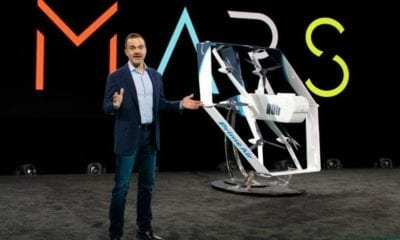The Fake Drone Spewing Blimp
Amazon’s drone spewing blimp is the eye of a storm stirred by a fake video doing the rounds on social media. The video shows a blimp with the brand of retailing giant Amazon painted on, releasing dozens of delivery drones with one popular post on Facebook captioned “The future delivery is here”.
ドローンで配送するという話があったけど、もう始まってたんだな。もっと先の話かと思ってた。
There was a talk about delivery by drone, but it had already started. I thought it was a story ahead.#エイプリルフール #zozi撮影 pic.twitter.com/hFrmGOKwof
— zozi(厳島神社の人) (@zozi009) March 31, 2019
In reality the video was a computer-generated clip created by a digital artist and not a genuine video of an Amazon blimp releasing delivery drones. The video comes courtesy a Twitter user zozi009, a video production artist in Hiroshima, Japan. They quickly uploaded a video showing how they made their very convincing graphics also posting a few diagrams of their unfinished work:
午後のネタバレ。信じてる人は皆無だろうけど一応。thetaVでHDRI作ってそのままライティングした。後ろに余計なものも入れてみたけどあまり気づかれてない模様。 pic.twitter.com/o4P8z5agz9
— zozi(厳島神社の人) (@zozi009) April 1, 2019
There is never smoke without fire though- the Amazon blimp isn’t entirely based on a fictional idea. It’s based on an actual patent Amazon filed back in December 2016 for a drone delivery service, Amazon patented the idea of floating blimp-like airships – called “airborne fulfillment centers” – that would store products midair, and an accompanying network of drones – called “unmanned aerial vehicles” – that would pick up items from the blimp and deliver them to customers.
あなたが作ったものか?ネットの動画を加工したものか?とか言ってくるから元動画もアップしとく。 pic.twitter.com/VJBZJHFaza
— zozi(厳島神社の人) (@zozi009) April 3, 2019
While speculations arose about the biggest threat to the future workforce- automation; it restarted the whole privacy issue surrounding autonomous drones as well. Amazon has tested out drone delivery on a small scale in the UK countryside, besides mention of a “Prime Air” delivery system ‘coming soon’ on its website.
Apparently Amazon’s strategy is to combine the conventional hot air balloon and technology to cut the noise pollution. So, its “unmanned aerial vehicle with inflatable membrane” would have a balloon hidden inside the chassis to be inflated using compressed gas, via a tank or chamber also carried on the drone. When the UAV roamed into an area where noise levels needed to be cut – such as the delivery location, Amazon suggests – the balloon could be inflated.
The balloon system would be used to raise and lower the UAV to and from the delivery location reducing the noise and energy involved in achieving a cruising altitude, where the balloon would be deflated and gathered back into its dock.
The drone would proceed to the delivery destination, and the balloon would be re-inflated and be used to gently lower the aircraft to the ground, to leave behind its package.
An inflating balloon near a system of fast-spinning propellers doesn’t go well together so part of Amazon’s patent outlines the retracting mechanism by which the two elements would be kept apart. Handled by an onboard autopilot, the balloon would be reeled back into the storage area. The drone could either return the gas used for inflation to the compression chamber, or allow it to escape.
As of now people’s reactions to the CGI video circulating online indicate that plenty of people are fine with the drone spewing blimp.


























